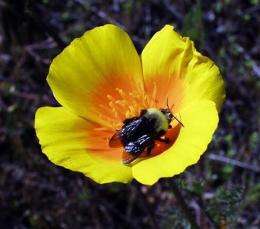Group seeks endangered listing for bumblebee

(AP) -- A conservation group filed a petition Wednesday to add a bumblebee from Southern Oregon and Northern California to the endangered species list.
The Society for Invertebrate Conservation and University of California at Davis entomologist Robbin Thorp formally petitioned the U.S. Fish and Wildlife Service to protect the insect - called a Franklin's bumblebee - under the Endangered Species Act.
Scott Hoffman Black, executive director of the of the Xerces Society in Portland, said the petition is part of an effort to reverse the decline of bumblebees and other native bees around the world due to habitat loss, pesticides and diseases spilling out of commercial greenhouses.
The group is preparing petitions to protect other bumblebee species as well. The Franklin's bee was chosen for this petition because documentation of its decline is more detailed than for other species. Thorp found 94 Franklin's bumblebees in 1994, but he has seen none since 2006.
Farmers often hire honeybee keepers to pollinate crops, but hives have been decimated by a mysterious honeybee killer known as colony collapse disorder.
So some farmers are turning to bumblebees to pollinate, especially for hothouse crops such as tomatoes, peppers and strawberries, and field crops such as blueberries, cranberries, raspberries, squash and watermelon. Bumblebees pollinate about 15 percent of all crops grown in the nation, worth $3 billion.
"The decline in Franklin's bumblebee should serve as an alarm that we are starting to lose important pollinators," Black said. "We hope that Franklin's bumblebee will remind us to prevent pollinators across the U.S. from sliding toward extinction."
While many native pollinators have seen declines related to loss of habitat and pesticides, Franklin's bumblebee and some related species have suffered deep and sudden declines that Thorp has theorized may be related to a fungus that was inadvertently transported with bumblebees brought from Europe for commercial use.
Researchers at the University of Illinois are working to see if the fungus known as nosema bombus caused declines in a number of related bumblebees, including the once-common Western bumblebee, the rusty-patched bumblebee, and the yellow-banded bumblebee in the Northeast.
Earlier this year, the Xerces Society and other conservation groups and scientists called on federal agricultural authorities to start regulating shipments of commercially domesticated bumblebees to protect wild bumblebees from diseases threatening their survival.
A 2007 National Academy of Sciences report blamed the decline of pollinators around the world on a combination of habitat loss, pesticides, pollution and diseases spilling out of greenhouses using commercial bumblebees.
©2010 The Associated Press. All rights reserved. This material may not be published, broadcast, rewritten or redistributed.

















